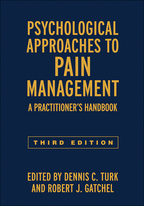Psychological Approaches to Pain Management
Third Edition
A Practitioner's Handbook
Edited by Dennis C. Turk and Robert J. Gatchel
Hardcovere-bookprint + e-book
Hardcover
orderJuly 3, 2018
ISBN 9781462528530
Price: $88.00586 Pages
Size: 7" x 10"
“The field of pain management will need a stronger relationship with the biopsychosocial perspective if pain care is to improve. This book is foundational in strengthening such a relationship. The third edition embodies the wisdom of many respected clinicians and scholars who discuss psychological/behavioral aspects of pain and provide direct, evidence-based recommendations on both the 'what' and 'how' of clinical practice. Existing chapters have been updated and new chapters added on cutting-edge topics as mobile health pain technologies, psychological resilience, and the management of comorbid substance use disorder. I highly recommend this handbook to students, clinicians, researchers, and policymakers. It continues to be a mainstay on my bookshelf.”

—David A. Williams, PhD, Department of Anesthesiology and Associate Director, Chronic Pain and Fatigue Research Center, University of Michigan
“Turk and Gatchel have assembled an all-star cast of distinguished clinician-scientists to review the theories, research, and applications that have generated the exciting contemporary field of pain psychology. The writing is clear and the story well told—there is something for everyone interested in pain. For psychology students, the entire volume is 'must' reading. For behavioral clinicians, each chapter provides very practical clinical instructions, illustrated with sample dialogues and helpful tables and figures, and updates the latest evidence supporting different therapies. There is also much here for pain medicine specialists, who should familiarize themselves with this book to help them work effectively with their behavioral team members. The chapter on enhancing motivation to change is particularly pertinent.”

—Rollin M. Gallagher, MD, MPH, Editor-in-Chief, Pain Medicine; Director for Pain Policy Research and Primary Care, Penn Pain Medicine, University of Pennsylvania
“This handbook continues to be the foremost reference for anyone interested in treating pain from a cognitive-behavioral perspective. The third edition profits from the wealth of new research that has facilitated mechanism-based psychological interventions for both acute and chronic pain. It covers established and novel pain management approaches and presents detailed treatment suggestions for prevalent pain syndromes. New and exciting approaches include methods to enhance resilience and interventions based on advanced technologies; the book also addresses the growing number of patients with comorbid psychological disorders. Combining scientific rigor with very clear instruction for clinical practice, this book meets the needs of clinicians, scientists, and students alike.”

—Herta Flor, PhD, Professor of Neuropsychology and Clinical Psychology, Medical Faculty Mannheim, Heidelberg University, Germany
“This is the most comprehensive handbook detailing psychological approaches to pain management available today. Readers will appreciate the well-organized, integrated presentations of conceptual issues; the diversity of approaches; and the applications to treatment of various pain populations. The third edition is greatly enhanced with new additions addressing areas of increasing interest. This is a 'must-have' resource for clinicians and researchers in pain medicine. It is also an effective teaching tool for trainees in any pain-related discipline.”

—Akiko Okifuji, PhD, Division of Pain Medicine, Department of Anesthesiology, University of Utah
—David A. Williams, PhD, Department of Anesthesiology and Associate Director, Chronic Pain and Fatigue Research Center, University of Michigan
“Turk and Gatchel have assembled an all-star cast of distinguished clinician-scientists to review the theories, research, and applications that have generated the exciting contemporary field of pain psychology. The writing is clear and the story well told—there is something for everyone interested in pain. For psychology students, the entire volume is 'must' reading. For behavioral clinicians, each chapter provides very practical clinical instructions, illustrated with sample dialogues and helpful tables and figures, and updates the latest evidence supporting different therapies. There is also much here for pain medicine specialists, who should familiarize themselves with this book to help them work effectively with their behavioral team members. The chapter on enhancing motivation to change is particularly pertinent.”
—Rollin M. Gallagher, MD, MPH, Editor-in-Chief, Pain Medicine; Director for Pain Policy Research and Primary Care, Penn Pain Medicine, University of Pennsylvania
“This handbook continues to be the foremost reference for anyone interested in treating pain from a cognitive-behavioral perspective. The third edition profits from the wealth of new research that has facilitated mechanism-based psychological interventions for both acute and chronic pain. It covers established and novel pain management approaches and presents detailed treatment suggestions for prevalent pain syndromes. New and exciting approaches include methods to enhance resilience and interventions based on advanced technologies; the book also addresses the growing number of patients with comorbid psychological disorders. Combining scientific rigor with very clear instruction for clinical practice, this book meets the needs of clinicians, scientists, and students alike.”
—Herta Flor, PhD, Professor of Neuropsychology and Clinical Psychology, Medical Faculty Mannheim, Heidelberg University, Germany
“This is the most comprehensive handbook detailing psychological approaches to pain management available today. Readers will appreciate the well-organized, integrated presentations of conceptual issues; the diversity of approaches; and the applications to treatment of various pain populations. The third edition is greatly enhanced with new additions addressing areas of increasing interest. This is a 'must-have' resource for clinicians and researchers in pain medicine. It is also an effective teaching tool for trainees in any pain-related discipline.”
—Akiko Okifuji, PhD, Division of Pain Medicine, Department of Anesthesiology, University of Utah



